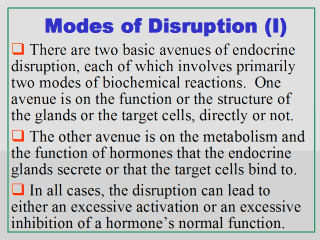| front |1 |2 |3 |4 |5 |6 |7 |8 |9 |10 |11 |12 |13 |14 |15 |16 |17 |18 |19 |20 |review |
 |
From a brief
review of the endocrine system provided in the previous slides, it becomes
clear that adverse health effects can result from unwanted interference with
the production or the function of hormones. It also should be transparent
that not all endocrine disruption per se is detrimental, as readily
reflected in the intended use of the now banned synthetic estrogen DES
(diethylstilbestrol). Within the context of this lecture, however, the focus
hereupon is on the side of unintended disruption. Endocrine disruption is actually a form of biochemical (re)actions which, when sufficient enough, can lead to one or more (adverse) health outcomes; that is, it is not necessarily an immediate toxicological endpoint per se. Despite the fact that often times the public health interest is in the epidemiologic link between a cause and the effect(s), an understanding of the causal mechanism is often advantageous and some times even necessary. In the case with endocrine disruption, students certainly would become more appreciative of the related health concerns if they could gain a basic understanding of the underlying mechanisms first. There are mainly two avenues of endocrine disruption, each of which involves primarily two modes of biochemical actions. One avenue is directly or indirectly on the structure or the function of the endocrine glands or of the target cells, whereas the other is on the metabolism or the function of hormones that the glands secrete or that the target cells bind to. In either case, the disruption can lead to an excessive activation or an excessive inhibition of a hormone’s normal function. In short, the major modes of disruption involve modification of or damage to the endocrine system or to target cells, and binding of or damage to hormones. |